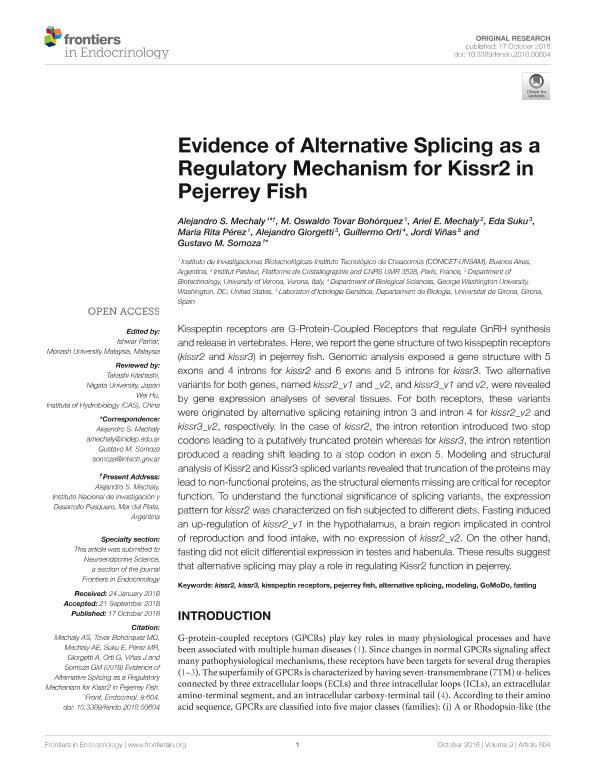Mostrar el registro sencillo del ítem
dc.contributor.author
Mechaly, Alejandro

dc.contributor.author
Bohórquez, M. Oswaldo Tovar
dc.contributor.author
Mechaly, Ariel Edgardo

dc.contributor.author
Suku, Eda
dc.contributor.author
Pérez, María Rita

dc.contributor.author
Giorgetti, Alejandro

dc.contributor.author
Orti, Guillermo

dc.contributor.author
Viñas de Puig, Jordi

dc.contributor.author
Somoza, Gustavo Manuel

dc.date.available
2020-02-26T14:10:18Z
dc.date.issued
2018-10
dc.identifier.citation
Mechaly, Alejandro; Bohórquez, M. Oswaldo Tovar; Mechaly, Ariel Edgardo; Suku, Eda; Pérez, María Rita; et al.; Evidence of alternative splicing as a regulatory mechanism for KISSR2 in pejerrey fish; Frontiers Media S.A.; Frontiers in Endocrinology; 9; OCT; 10-2018; 1-12
dc.identifier.issn
1664-2392
dc.identifier.uri
http://hdl.handle.net/11336/98408
dc.description.abstract
Kisspeptin receptors are G-Protein-Coupled Receptors that regulate GnRH synthesis and release in vertebrates. Here, we report the gene structure of two kisspeptin receptors (kissr2 and kissr3) in pejerrey fish. Genomic analysis exposed a gene structure with 5 exons and 4 introns for kissr2 and 6 exons and 5 introns for kissr3. Two alternative variants for both genes, named kissr2_v1 and _v2, and kissr3_v1 and v2, were revealed by gene expression analyses of several tissues. For both receptors, these variants were originated by alternative splicing retaining intron 3 and intron 4 for kissr2_v2 and kissr3_v2, respectively. In the case of kissr2, the intron retention introduced two stop codons leading to a putatively truncated protein whereas for kissr3, the intron retention produced a reading shift leading to a stop codon in exon 5. Modeling and structural analysis of Kissr2 and Kissr3 spliced variants revealed that truncation of the proteins may lead to non-functional proteins, as the structural elements missing are critical for receptor function. To understand the functional significance of splicing variants, the expression pattern for kissr2 was characterized on fish subjected to different diets. Fasting induced an up-regulation of kissr2_v1 in the hypothalamus, a brain region implicated in control of reproduction and food intake, with no expression of kissr2_v2. On the other hand, fasting did not elicit differential expression in testes and habenula. These results suggest that alternative splicing may play a role in regulating Kissr2 function in pejerrey.
dc.format
application/pdf
dc.language.iso
eng
dc.publisher
Frontiers Media S.A.

dc.rights
info:eu-repo/semantics/openAccess
dc.rights.uri
https://creativecommons.org/licenses/by/2.5/ar/
dc.subject
ALTERNATIVE SPLICING
dc.subject
FASTING
dc.subject
GOMODO
dc.subject
KISSPEPTIN RECEPTORS
dc.subject
KISSR2
dc.subject
KISSR3
dc.subject
MODELING
dc.subject
PEJERREY FISH
dc.subject.classification
Bioquímica y Biología Molecular

dc.subject.classification
Ciencias Biológicas

dc.subject.classification
CIENCIAS NATURALES Y EXACTAS

dc.title
Evidence of alternative splicing as a regulatory mechanism for KISSR2 in pejerrey fish
dc.type
info:eu-repo/semantics/article
dc.type
info:ar-repo/semantics/artículo
dc.type
info:eu-repo/semantics/publishedVersion
dc.date.updated
2020-02-20T15:09:38Z
dc.journal.volume
9
dc.journal.number
OCT
dc.journal.pagination
1-12
dc.journal.pais
Reino Unido

dc.journal.ciudad
Bristol
dc.description.fil
Fil: Mechaly, Alejandro. Consejo Nacional de Investigaciones Científicas y Técnicas. Centro Científico Tecnológico Conicet - Mar del Plata. Instituto de Investigaciones en Biodiversidad y Biotecnología; Argentina
dc.description.fil
Fil: Bohórquez, M. Oswaldo Tovar. Instituto Nacional de Investigaciones y Desarrollo Pesquero; Argentina
dc.description.fil
Fil: Mechaly, Ariel Edgardo. Consejo Nacional de Investigaciones Científicas y Técnicas. Centro Científico Tecnológico Conicet - La Plata. Instituto de Investigaciones Biotecnológicas. Universidad Nacional de San Martín. Instituto de Investigaciones Biotecnológicas; Argentina
dc.description.fil
Fil: Suku, Eda. Centre National de la Recherche Scientifique; Francia
dc.description.fil
Fil: Pérez, María Rita. Universita di Verona; Italia
dc.description.fil
Fil: Giorgetti, Alejandro. Consejo Nacional de Investigaciones Científicas y Técnicas. Centro Científico Tecnológico Conicet - La Plata. Instituto de Investigaciones Biotecnológicas. Universidad Nacional de San Martín. Instituto de Investigaciones Biotecnológicas; Argentina
dc.description.fil
Fil: Orti, Guillermo. Universita di Verona; Italia
dc.description.fil
Fil: Viñas de Puig, Jordi. Universidad de Girona; España
dc.description.fil
Fil: Somoza, Gustavo Manuel. Consejo Nacional de Investigaciones Científicas y Técnicas. Centro Científico Tecnológico Conicet - La Plata. Instituto de Investigaciones Biotecnológicas. Instituto de Investigaciones Biotecnológicas "Dr. Raúl Alfonsín" (sede Chascomús). Universidad Nacional de San Martín. Instituto de Investigaciones Biotecnológicas. Instituto de Investigaciones Biotecnológicas "Dr. Raúl Alfonsín" (sede Chascomús); Argentina
dc.journal.title
Frontiers in Endocrinology
dc.relation.alternativeid
info:eu-repo/semantics/altIdentifier/url/https://www.frontiersin.org/articles/10.3389/fendo.2018.00604/full
dc.relation.alternativeid
info:eu-repo/semantics/altIdentifier/doi/https://doi.org/10.3389/fendo.2018.00604
dc.relation.alternativeid
info:eu-repo/semantics/altIdentifier/url/https://www.ncbi.nlm.nih.gov/pmc/articles/PMC6200147/
Archivos asociados
